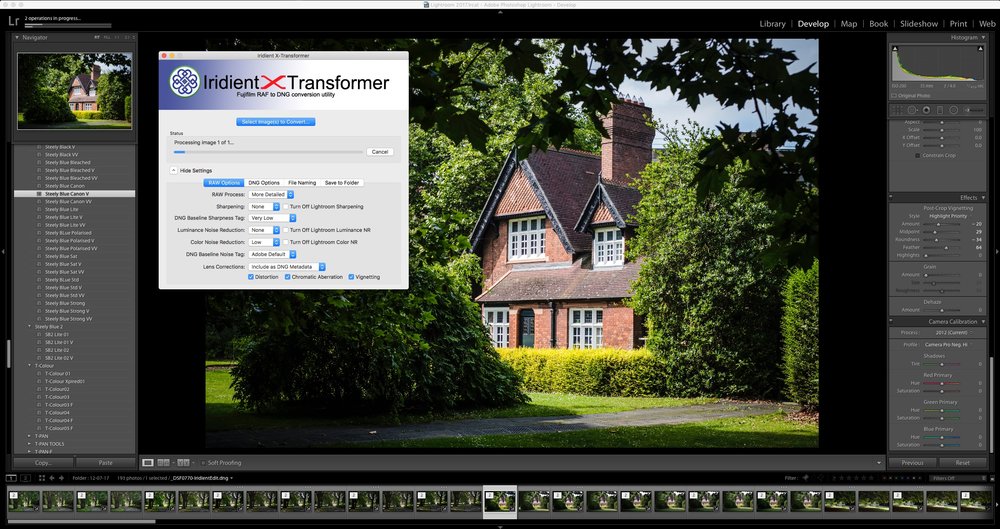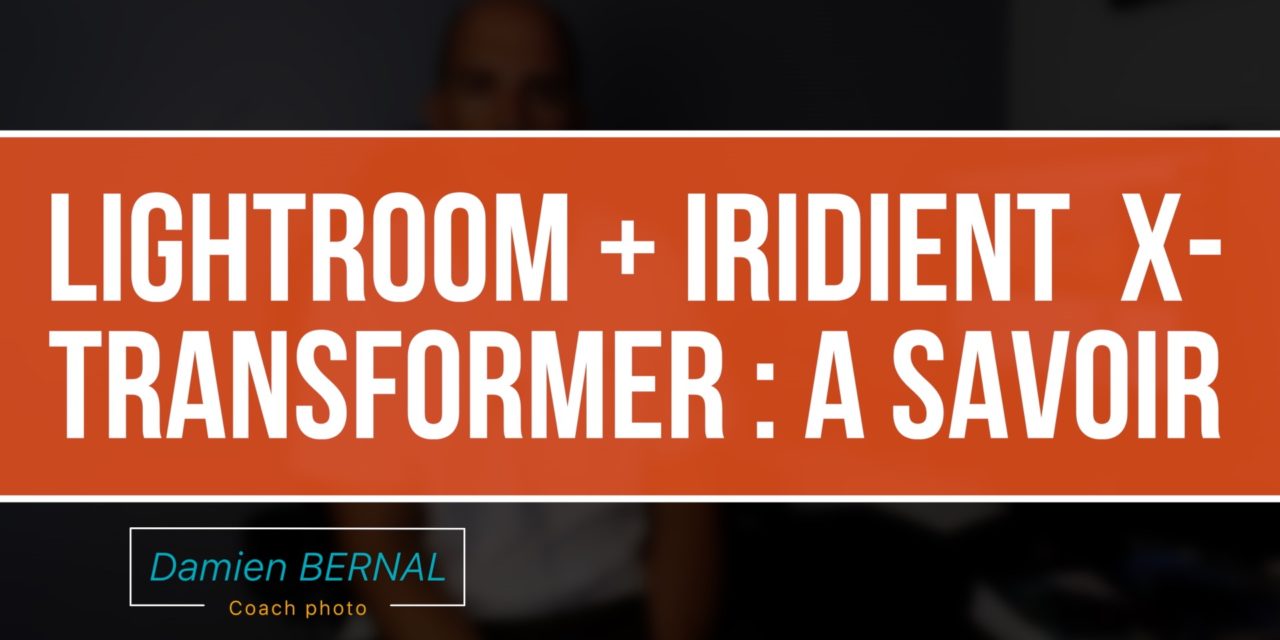Iridient S-Transformer

Iridient X-Transformer
Download Free DemoIridient X-Transformer is a utility that can be used to convert Fujifilm RAF images to DNG format using Iridient Digital's high quality RAW processing algorithms. Much of the core RAW processing, sharpening, noise reduction and lens corrections featured in this program are shared with Iridient Developer a more full-featured RAW processor that is available only for macOS.
Iridient S-Transformer 1.0 beta 1 is now available! I am very happy to finally announce Iridient S-Transformer 1.0 is now available in public beta on both macOS and Windows!! This new program is a Sony ARW/ARQ to DNG converter utility and the second in a series of new cross platform Iridient DNG conversion products. There are a few ways to deal with Lightrooms issues with handling Fuji RAW files. In this video, Lightroom Enhance Details feature is compared with Iridient.
The Iridient RAW processing routines have been in active development for over 15 years for use in Iridient Developer and have been optimized and refined over the years for the best possible image quality. Iridient Developer is widely regarded as one of the highest quality RAW processors available.
This program converts Fujifilm's proprietary RAF image data to the openly specified DNG image format. The DNG format was created and is publicly documented by Adobe. They have detailed information regarding the format on their website here:
Adobe DNG information
The key RAW processing stages that can be applied by Iridient X-Transformer during conversion to DNG include:
- Interpolation or demosaic processing. This transforms the camera sensor's X-Trans or Bayer color filter information to produce a full color RGB image. This processing is always applied by Iridient X-Transformer and cannot be disabled or undone. There are two interpolation options, one for a more detailed rendering and a second smoother, lower artifact version. The algorithms are identical to the latest 'detail+' and 'smooth' options in Iridient Developer 3.4.1.
- Sharpening. Iridient X-Transformer features advanced sharpening based on the very highly regarded 'Iridient Reveal' sharpening algorithms featured in Iridient Developer. Sharpening is optional and can be adjusted (low/med/high) or disabled.
- Automatic lens corrections for distortion, chromatic aberration and vignetting. Corrections are based on native Fujifilm lens information specified in their RAF metadata. The lens correction stage is optional and lens correction information can also be passed on through DNG opcode metadata and left to later processing stages or ignored altogether. The lens correction processing in Iridient X-Transformer uses the same high quality resampling algorithms as Iridient Developer.
- Color and luminance noise reduction. The noise reduction processing in Iridient X-Transformer shares much in common with the latest noise reduction available in Iridient Developer and is specifically optimized for RAW image processing. Noise reduction is optional and can be adjusted (low/med/high) or disabled.
I use Adobe Lightroom as my raw processing software of choice and I have done so since it was first released. Back then I was a Canon shooter but for the last several years I’ve been shooting more and more Fuji to the point where as I write I’ve not shot using my Canon gear for over a year.

As a Fuji shooter I have been aware of the raw processing software “Iridient Developer” for quite some time. I have often been astonished by the apparent difference in the rendering of Fuji raw files between Adobe Lightroom and Iridient Developer. Iridient seemed to create cleaner, clearer, sharper renderings of the same image. This seemed all the more remarkable as Iridient Digital is a “small” company, indeed to the best of my knowledge a “one-man band”.
Impressed as I was by the results I was seeing being obtained using Iridient Developer it was sadly not for me. The software was only available for Mac OS and I switched back from Mac OS to Windows several years ago now. As a keen amateur photographer (ie – not somebody who makes a lot of money out of photography) I was not going to switch back to using Macs again just to be able to run Iridient Developer, no matter how much better it might make my results.
Last year I read rumors that Iridient were working on “something for Windows”. This was exciting news for me as I found it galling that despite much improvement over the last couple of years Lightroom still didn’t seem to render Fuji raw files as well as Iridient did.
I had been checking the Iridient Digital web site for any further news of a Windows release for several months and then just as it seemed like nothing was ever going to happen I seem to have missed the notification by about a week.
Iridient X-Transformer isn’t a full-blown raw processing package. What it does is de-mosaic the Fuji raw file and store it as a dng (Digital Negative) file. Rtcctool report sap. Once X-Transformer has produced the dng file you are free to import it into any raw processor you like which supports the dng format – for example Adobe Lightroom.
Over the last year or so I had been thinking that Lightroom had caught up a lot and maybe there wouldn’t be a whole lot of difference between X-Transformer results and a native Lightroom import.
I was wrong!
The comparison I posted at the head of this post shows very clearly just how much of a difference there is (click on the image to see the full size version). This is a photo I took of my daughter during a visit to Bolsover Castle on December 27th 2016. It just happened to be one of my favourite portraits of her for quite a while so it was foremost in my mind and I thought that the catch-lights in her eyes along with her eyelashes and eyebrows would give X-Transformer a good test. Lots of fine detail in the shot.
The original Lightroom import to the left looks almost like there’s something over the top of the image which makes it less distinct, although at the time I took it I was pleased enough with the photo. The eyebrows and lashes almost seem to smear together, the catch-light just isn’t crisp.
Iridient X Transformer Lightroom Plugin

Looking at the X-Transformer processed version to the right is like putting on a pair of spectacles.
And when I say “processed” both of these images are before I’ve done any actual edits on them. The only processing has been importing into Lightroom and in the case of the X-Transformer version being converted to a dng and then importing into Lightroom. Everything is set to “default” for both versions.
The results appear to be so clear, so crisp and so sharp that I think I might need to tone down my homemade Lightroom preset for sharpening X-Trans files.
The image shown in the comparison was produced with X-Transormer before I paid to register it – an event which happened very shortly after I carried out the comparison! It cost me around £32 to purchase the software and this seems like very good value for money to reveal the true brilliant performance of all of my Fuji X-Mount lenses (and my X100T).
I intend to add X-Transformer into my Lightroom workflow by pre-processing all of my Fuji shot photos though it before importing the batch to Lightroom. X-Transformer can also be used from within Lightroom as an “external editor” (once configured according to the instructions included in the help file) – right click a photo in Lightroom and send it to X-Transformer.
It seems that X-Transformer is very aptly named. It really does transform your X-Trans photos if you’re used to the results Adobe Lightroom produces.
Iridient X-transformer Coupon Code
Edit : A bit of an oversight maybe not to show the whole of the image I used for the comparison in this post. This is after processing in Lightroom but not shown at full size.
